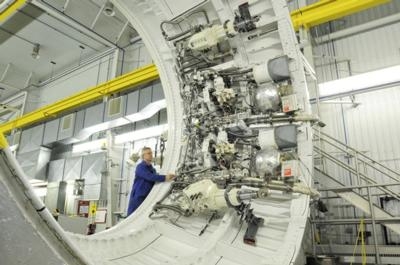Tue, Feb 05, 2013
ATK Says It Has Designed Affordability Into New Avionics Subsystem
The second in a series of development tests for NASA's Space Launch System (SLS) booster program was completed by NASA and ATK on January 30 at ATK's Promontory, Utah, test facility. This key avionics and controls test was designated Flight Control Test 2 (FCT-2) and included a "hot fire" of the fully integrated heritage thrust vector control (TVC), the new SLS booster avionics subsystem and new electronic support equipment (ESE).

FCT-2 focused on replacement of heritage test equipment with new ESE. Much of the equipment replaced was designed and built during the mid- to late-1970s and was successfully used on all Space Shuttle Reusable Solid Rocket Motor (RSRM) and five segment RSRM static motor firings.
"The FCT-2 test marked a definite milestone for ATK and NASA's SLS program," said Fred Brasfield, ATK's vice president, Next-Generation Booster. "Working with Marshall, we have designed and developed a modern system and common interface that allows for multiple uses of the same equipment at all necessary locations for both qualification and operational phases of the program, greatly reducing complexity and costs."
As with the avionics subsystem, affordability was designed in from the onset of developing new ESE. The same ESE design utilized to support static tests will also be used to support certification testing of the avionics subsystem in Utah and at NASA's Marshall Space Flight Center, and ultimately for acceptance check-out of flight hardware at Kennedy Space Center (KSC).
ATK developed the avionics subsystem at facilities in Clearfield and Magna, Utah, with support from NASA Marshall Space Flight Center in Alabama. Key partners supporting ATK throughout this test series include L-3 Cincinnati Electronics in Mason, Ohio, and Southern California Braiding, an IEC Electronics Company in Bell Gardens, California. Cincinnati Electronics provides the avionics boxes, and Southern California Braiding is responsible for the cable harnesses. Both Cincinnati Electronics and Southern California Braiding have been integral to ATK throughout the development lifecycle of the SLS booster.
"Our suppliers have been vital to the success of this program," said Brasfield. "They will remain key contributors through the SLS flight test program."
(Image provided by ATK)
More News
Also: Vertical Flight Society, NBAA Maintenance Conference, GA Honored, AMT Scholarship For the first time, students from Embry-Riddle’s Daytona Beach, Florida, campus took t>[...]
Hazardous Weather Information Summary of significant meteorological information (SIGMET/WS), convective significant meteorological information (convective SIGMET/WST), urgent pilot>[...]
"The need for innovation at speed and scale is greater than ever. The X-62A VISTA is a crucial platform in our efforts to develop, test and integrate AI, as well as to establish AI>[...]
(FAA) Inspector Observed That Both Fuel Tanks Were Intact And That Only A Minimal Amount Of Fuel Remained In Each Analysis: According to the pilot, approximately 8 miles from the d>[...]
“Pyka’s Pelican Cargo is unlike any other UAS solution on the market for contested logistics. We assessed a number of leading capabilities and concluded that the Pelica>[...]
 Airborne-Flight Training 05.09.24: ERAU at AIAA, LIFT Diamond Buy, Epic A&P
Airborne-Flight Training 05.09.24: ERAU at AIAA, LIFT Diamond Buy, Epic A&P ANN's Daily Aero-Term (05.07.24): Hazardous Weather Information
ANN's Daily Aero-Term (05.07.24): Hazardous Weather Information Aero-News: Quote of the Day (05.07.24)
Aero-News: Quote of the Day (05.07.24) NTSB Final Report: Cessna 150
NTSB Final Report: Cessna 150 Aero-News: Quote of the Day (05.08.24)
Aero-News: Quote of the Day (05.08.24)



